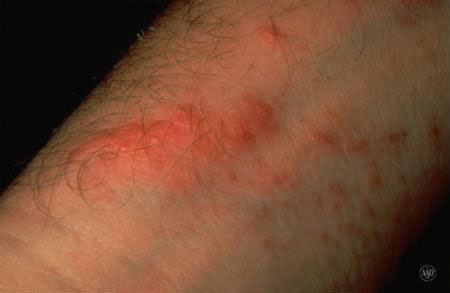Poison ivy, Oak, and Sumac: Diagnosis and treatment

How do you get a rash from poison ivy, oak, or sumac?
Every part of these plants — the leaves, stem, vines, flowers, and roots — contains an oil called urushiol (yur-oo-shee-aal). When this oil touches your skin, it can cause an allergic reaction. Anyone who develops an allergic reaction gets a rash.
It’s easy to get this oil on your skin. This can happen when you:
• Brush up against one of these plants.
• Touch something that has the oil on it, such as your clothing, pet’s fur, or gardening tools.
• Get tiny pieces of these plants on your skin or clothing when someone in the area mows or whacks at these plants to get rid of them.
How does the rash show up on the skin?
It takes time for the rash to appear. A rash can develop in a few hours if you’ve had a rash from one of these plants before. If you’ve never had a rash from poison ivy, oak, or sumac, it can take 2 to 3 weeks before you see a rash.
No matter how long it takes for the rash to appear, most people experience the following when they get a rash:
1. The skin itches intensely where the rash will appear. The itch can be so intense that it wakes you from a sound sleep.
2. Shortly after your skin starts to itch, the rash appears. Most people develop an itchy, red, and blistering rash.
3. If you have blisters, they break open and leak fluid.
4. The blisters crust over, and the rash clears in 2 to 3 weeks. The rash will clear without treatment, but it can be extremely itchy until it clears completely.
The intensity of the itch and severity of the rash can differ from person to person. Some people develop 1 or 2 small rashes. Others develop rashes all over.
**If you have any of the following, go to the emergency room immediately:
• Difficulty breathing or swallowing
• A rash around one or both eyes, your mouth, or on your genitals
• Swelling on your face, especially if an eye swells shut
• Itching that worsens or makes it impossible to sleep
• Rashes on most of your body
• A fever
These are signs of a severe reaction that require immediate medical care.
You can treat the rash at home if you:
• Have a mild rash
• Developed a rash on a small section of skin
• Are certain that the rash is due to poison ivy, oak, or sumac
To treat a mild rash and help stop the itch, dermatologists recommend the following:
• Immediately rinse your skin with lukewarm, soapy water. If you can rinse your skin immediately after touching poison ivy, poison oak, or poison sumac, you may be able to rinse off some of the oil. If not washed off, the oil can spread from person to person and to other areas of your body.
• Wash your clothing. Thoroughly wash all of the clothes you were wearing when you came into contact with the poisonous plant. The oil can stick to clothing, and if it touches your skin, it can cause another rash.
• Do not scratch, as scratching can cause an infection.
• Leave blisters alone. If blisters open, do not remove the overlying skin, as the skin can protect the raw wound underneath and prevent infection.
What can relieve the itch?
• Take short, lukewarm baths. To ease the itch, take short, lukewarm baths in a colloidal oatmeal preparation, which you can buy at your local drugstore. You can also draw a bath and add one cup of baking soda to the running water. Taking short, cool showers may also help.
• Use calamine lotion or hydrocortisone cream. Calamine lotion can reduce the itch. If you have a mild case, a hydrocortisone cream or lotion is another treatment that can alleviate the itch.
• Apply cool compresses to the itchy skin. You can make a cool compress by wetting a clean washcloth with cold water and wringing it out so that it does not drip. Then, apply the cool cloth to the itchy skin.
• Consider taking antihistamine pills. These pills can help reduce itching. You should not apply an antihistamine to your skin, as doing so can worsen the rash and the itch.
If your rash is not improving after 7 to 10 days, or you think your rash may be infected, see a board-certified dermatologist. A dermatologist can treat your rash and any infection and help relieve the itch.
Dermatologists emphasize that you only treat the rash if you’re absolutely certain that poison ivy, oak, or sumac caused it. If you’ve never had a poison ivy rash, see a doctor for a diagnosis.
Back to Skin Condition Library >